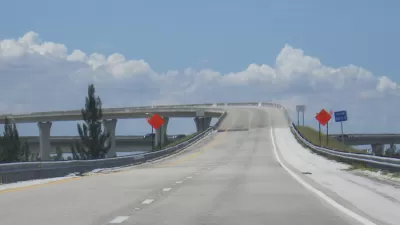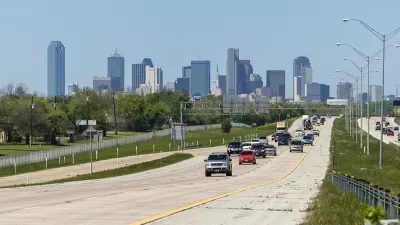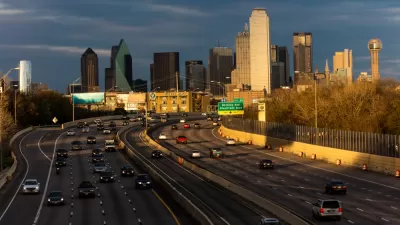Yonah Freemark critiques a planned expansion to Dallas' already-extensive highway network, arguing that it undermines billions of dollars in light rail investment and sets its downtown on a path of stunted growth.
For the home of the nation's longest light rail network, Dallas struggles with astonishingly low transit ridership – just 4.2%, according to data from the U.S. Census Bureau. In Freemark's view, that might just have something to do with the city's aggressive highway expansion policy.
For in addition to its extensive light rail system, Downtown Dallas is penetrated by seven grade-separated highways, and may soon see the addition of another. At roughly $1.5 billion, the new toll road is intended to relieve road congestion by building parallel to both existing highways and the new Orange Line, which will open this summer.
"This is transportation planning at its worst," Freemark opines. "Public dollars are being spent on two separate transportation projects that offer similar benefits and serve the same corridors. The advantages of the investments made in rail - namely, the ability to avoid congestion - are being marginalized by the construction of a huge new road that will, at least for a few years (until the congestion returns), make choosing the train a poor choice... And the result is that all this investment will again produce low ridership."
Proponents of the expansion argue that the toll road is critical to future growth, a claim that Freemark contends is misguided.
"Highways, by encouraging car use, make the walking, transit-oriented city impossible. The growth that Dallas has seen in its central areas could be ephemeral with the wrong decisions made."
FULL STORY: A Tollway in Dallas and the Absurdity of Building Duplicative Infrastructure

Alabama: Trump Terminates Settlements for Black Communities Harmed By Raw Sewage
Trump deemed the landmark civil rights agreement “illegal DEI and environmental justice policy.”

Planetizen Federal Action Tracker
A weekly monitor of how Trump’s orders and actions are impacting planners and planning in America.

The 120 Year Old Tiny Home Villages That Sheltered San Francisco’s Earthquake Refugees
More than a century ago, San Francisco mobilized to house thousands of residents displaced by the 1906 earthquake. Could their strategy offer a model for the present?

In Both Crashes and Crime, Public Transportation is Far Safer than Driving
Contrary to popular assumptions, public transportation has far lower crash and crime rates than automobile travel. For safer communities, improve and encourage transit travel.

Report: Zoning Reforms Should Complement Nashville’s Ambitious Transit Plan
Without reform, restrictive zoning codes will limit the impact of the city’s planned transit expansion and could exclude some of the residents who depend on transit the most.

Judge Orders Release of Frozen IRA, IIJA Funding
The decision is a victory for environmental groups who charged that freezing funds for critical infrastructure and disaster response programs caused “real and irreparable harm” to communities.
Urban Design for Planners 1: Software Tools
This six-course series explores essential urban design concepts using open source software and equips planners with the tools they need to participate fully in the urban design process.
Planning for Universal Design
Learn the tools for implementing Universal Design in planning regulations.
Clanton & Associates, Inc.
Jessamine County Fiscal Court
Institute for Housing and Urban Development Studies (IHS)
City of Grandview
Harvard GSD Executive Education
Toledo-Lucas County Plan Commissions
Salt Lake City
NYU Wagner Graduate School of Public Service





























